Goodness, after yesterday's extravaganza, I'm really hoping that Wednesday's lady will treat me a little kinder, especially as I have very little time today. For those who remember my daughter, you will be horrified to learn that she is 18 today! I personally don't believe it, as I think she is only around 6 or something. I feel old. Moving on. Today's subject is probably the latest-lived of our ladies, but proof that the ideas of Victoriana and Pre-Raphaelitism stretched well beyond the nineteenth century. Say hello to Violet Brunton...
Violet Ella Evelyn Brunton was born in Brighouse in Yorkshire on 28 October 1878. Her parents, Arthur (1848-1919) and Eliza (1849-1919) had married at Christmas 1877 - both were children of engineers and when they married, Arthur listed his occupation as an engineer. In the 1881 census he had become a 'corresponding clerk'. By 1891, Violet had been joined by little brother Harold (1882-1967), and both Arthur and Eliza are listed as painters, living in Birkdale on Merseyside - Arthur was a portraitist and Eliza, a miniaturist. In a piece on Violet's art in 1927, she said her mother had done a thousand pieces in miniature and portraits in coloured chalk by the time she died.
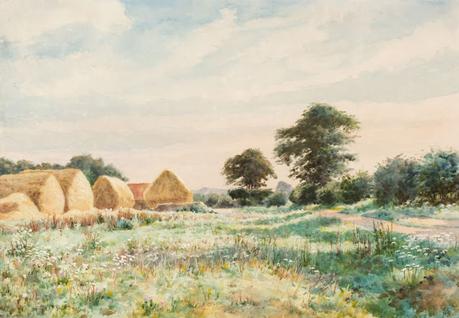
Yarrow's Field (1915) Arthur Brunton
By 1901, Arthur and Eliza had combined their art with teaching at the Southport School of Art, and Violet started by attending the Southport School of Art, then moved to the art school on Mount Street in Liverpool. She very quickly started to win medals in the National Competition (to which all art students could apply). In 1902, Violet gained a bronze medal for a design for a bronze panel which was reportedly 'good in design but somewhat careless in the treatment of figures.' In 1903 she won another bronze, this time for her design for a sundial, which appeared in art journals...
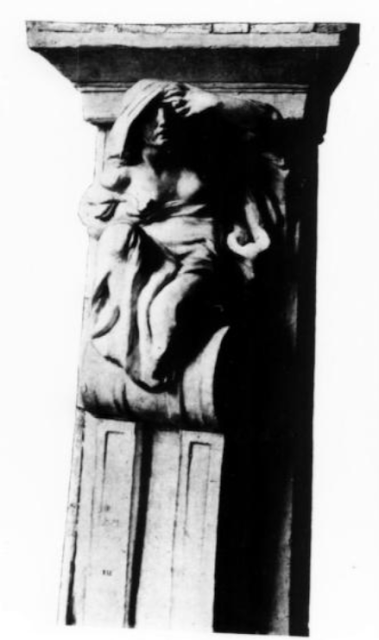
Please excuse the ropey image, it's still good to have it and you get the impression that Violet's art had less of the 'prettiness' about it than you would expect. Her sculpted figures have a power and immediacy that is striking even now...
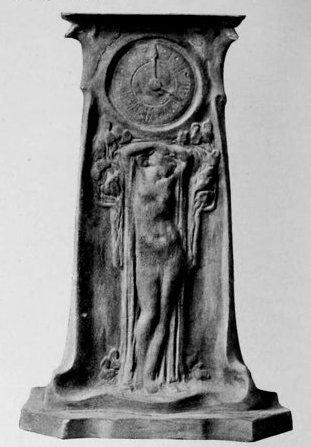
Clock (1902)
The International Studio in 1904 reported that Violet's work had gained her the County Palatine Scholarship of the city of Liverpool and was subsequently offered a place at the Royal College of Art - 'Violet Brunton is especially strong in modelling and her scholarship requires her to study in London. Her absence from Liverpool will be felt as a loss to the school.' This might have been when she also gained a silver medal for her work which is breath-taking...
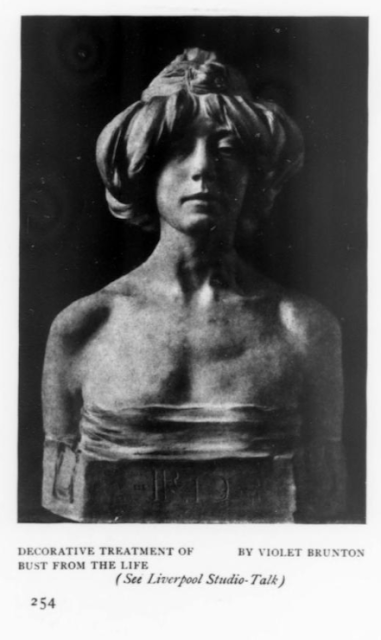
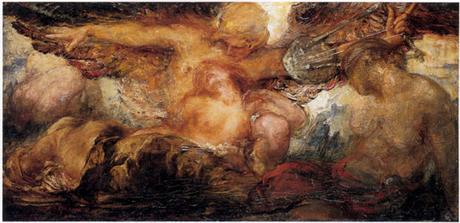
Orpheus and Eurydice (c.1910)
One thing I was surprised about while reading newspaper and Royal Academy entries on Violet was that, unlike a lot of other women we will see this month, it took her a while to gain entry to the Royal Academy's annual May exhibition (I suppose because of her sculptural leanings) and her fame came much later, as we will see. By 1906, Violet was back up in Southport offering sculpture lessons 'in all branches of modelling'. Violet advertised her silver and bronze medals together with 'highest certificates and recommendations' at her studio on the second floor of Nevill Street, 10am to 5pm daily.
Interesting, in the 1911 census, Violet had moved only a short distance from her studio and her parents, to Belmont Street, where she lived alone with a boarder whose name is all but illegible (Ancestry has gone with Shonait Fogen, which sounds delightful). In 1914, Violet exhibited a 'dainty drawing' in the Southport Art Exhibition. Violet remarked that she tried miniature painting like her mother, choosing her favorite cat as the subject but it went so badly that she didn't try again for a few years. I'll hand it to Violet, she understood a slow burn in terms of career...
In 1919, both Violet's parents died, first Eliza in January, then Arthur at the end of the year. Neither left her much in the way of money, but the 1920s seems to be when Violet found her groove in terms of work. She started again in miniature and was elected an Associate of the Royal Society of Miniature Painters, being elected a full member the year later, which was unprecedented. She also expanded her repertoire into illustration. I found it interesting that she didn't appear at the Royal Academy until the 1920s; she was well into her 40s, and it is sort of heart-warming as it never seems too late to find your fame. In 1925, she combined with archaeologist and artist Winifred Brunton (not a relative as far as I can see, but possibly a distant one) for an exhibition entitled 'Portraits of the Pharaohs and Queens of Egypt and Other Miniatures'. In a piece on the Art of the Miniature Painter in 1926, the author commented 'The keynote of Miss Brunton's work is extreme painstaking. The highest finish is applied to every part, the same focus being used throughout.'

Penelope (1920s)
1926 also saw her debut at the Royal Academy (at 48 years old) with two pieces, Jael and Gueneviere. Her address was given as 10 Riggindale Road, Streatham. I wonder once her parents died, Violet decided to move closer to London and the artistic (and economic) opportunities it offered. Her RA career certainly took off, with La Chatelain exhibited in 1927 and three pictures the following year, The Duchess, The Foreign Devil and A Burgundian Noble. She followed up with another three in 1929, The Jester, The Warden of the Bow and possibly my favorite title of the year, Portrait of a Man Smiling in an Enigmatical Manner.
1930 saw her marriage, aged 52, to music professor William Henry Angless who was twenty years her senior. He was a widower with adult children not much younger than Violet. The couple seem to have continued living in her home in Riggindale Road and Violet continued to work, exhibiting Fae and Little Jehane in the 1930 Royal Academy. 1931 brought Once Upon a Time and A Man with a Violin.
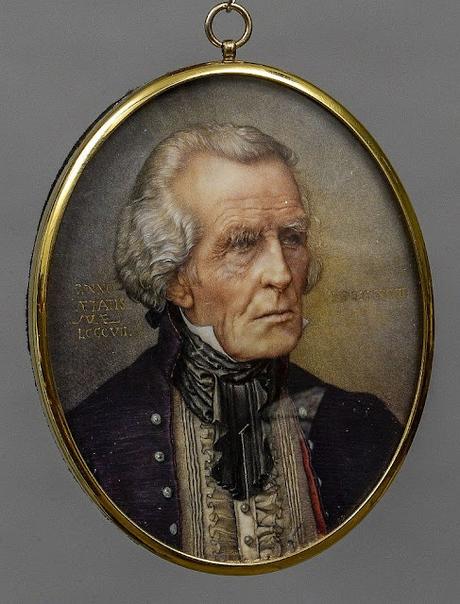
Alfred Oliphant as the Old Squire (1932)
In 1932 she exhibited miniatures The Old Squire and "Her Leddyship" which took me a moment to work out. It wasn't until 1933 that Violet decided to double-barrel her name, and she appeared in the RA catalog as Violet Brunton-Angless with her piece The Barbarian Envoy. 1934 brought A Young Man of Today but there was a few years gap before 1937's A Leisure Hour. At 60 years old, she was still exhibiting, showing the miniature John Ball Peasants' Revolt 1381 in 1939, then finally in 1940, she exhibited The Warden of the Bow, The Vidame and An Imagining.
Of course, miniature painting was not Violet's only output, and her book illustrations from the 1920s onwards made her famous. She occasionally used the pseudonym Victor du Lac, possibly aligning her art style with that of Edmund Dulac (1882-1958) a book illustrator working at the same time on similar material...
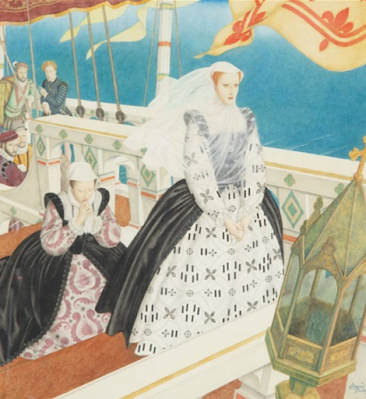
Mary Queen of Scots (c.1934) Edmund Dulac
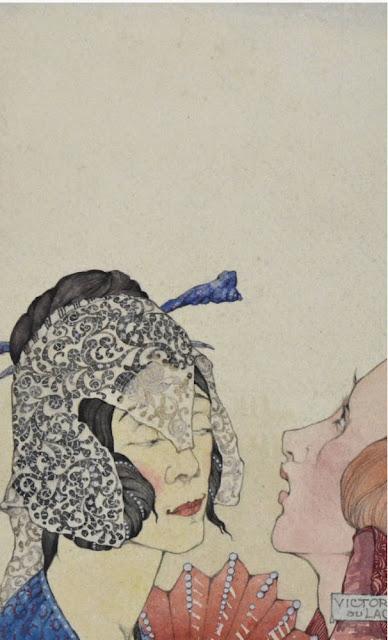
The Gossips (1926) signed Victor du Lac
Violet worked on Romer Wilson's Green Magic (1928) and Red Magic (1930) as well as Silver Magic (1929). I really loved a review from The Nation and Athenaeum in 1929 for Silver Magic - 'Violet Brunton's illustrations though clever, might easily be responsible for nightmares. She has an extraordinary power of drawing fearsome faces.'

Illustration from Ecclesiasticus (1927)
In 1927 John Lane The Bodley Head Ltd publishers published a new, illustrated edition of Ecclesiasticus, or The Book of Sirach and it was a sensation, as Bookseller magazine reported 'The idea of illustrating Ecclesiasticus, especially in colour, was a bold one, but Miss Brunton, who is already established in the front rank of English miniaturists has accomplished the task in a most original manner.' Between her miniature masterpieces and popular book illustrations, Violet became an artist who was popular and respected both with the public and critics alike.
I've always had a bit of a soft spot for miniaturists, so before I finish this post I just want to show you this beautiful little gem...
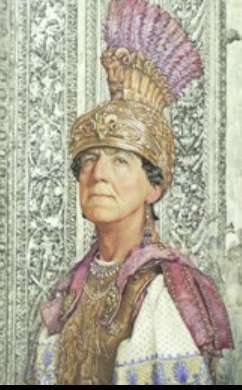
Captain Graham Archibald Hope RA Governor of the Province
Okay, so this is one of her most famous miniatures and it's not all it seems, especially when paired with this one...
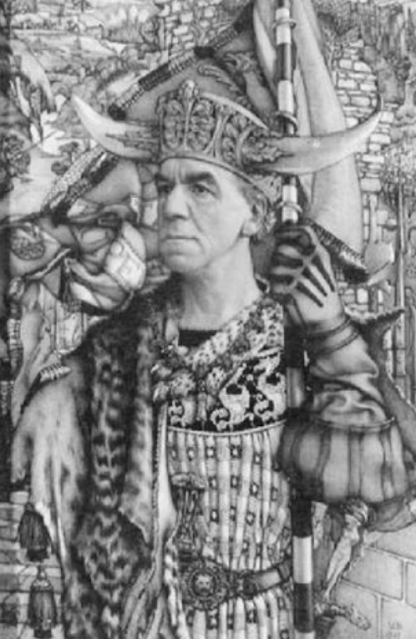
Captain Graham Archibald Hope RA as a Barbary Envoy (1927)
Righty-o then. So, the good Captain left the RA in 1904, after which he had been working as a journalist and ended up bankrupt. However, he served in the Great War and was a Captain once more. However, the tone of the pieces is so weird, I can only imagine he was a bit of a character and liked the idea of being the eternal soldier. It's his dignified expression that gets me.
In the 1939 census Violet and William were living at Riggindale Road; he was listed as a music teacher and she, as a miniature painter. Somewhen in the first years of the Second World War, Violet and William moved out of London to a bungalow in Chorleywood. William died in the January of 1943, aged 88, and his death after a sudden illness was announced in the Streatham News on 19th February. Violet was 64 and faded into retirement, living her life in Chorleywood, working for her church and community. In 1951, she had a bad fall while on holiday and died in hospital, aged 72. Unlike many of the women in this month, Violet had a glowing obituary in the paper, albeit the Buckinghamshire Examiner. A wreath was left at her local church with a card that read 'In grateful appreciation of many works of labor and love for the church.' She left £383 to her brother Harold and his wife Lily.

Portrait of An Old Chief (undated)
I think the thing I will remember about Violet is that she worked on what she loved and she made it eventually. She basically had her career highlights in her 50s and 60s which is encouraging. If we had more role models who tell us it is never to late to be a star I think a lot more people would feel reassured that their hard work would be worth it in the end.

